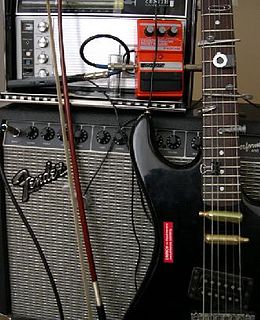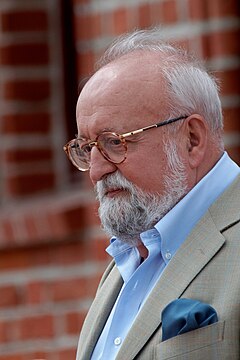
The double bass, also known simply as the bass, is the largest and lowest-pitched bowed string instrument in the modern symphony orchestra. Similar in structure to the cello, it has four, although occasionally five, strings.

Krzysztof Eugeniusz Penderecki was a Polish composer and conductor. His best known works include Threnody to the Victims of Hiroshima, Symphony No. 3, his St Luke Passion, Polish Requiem, Anaklasis and Utrenja. Penderecki's oeuvre includes four operas, eight symphonies and other orchestral pieces, a variety of instrumental concertos, choral settings of mainly religious texts, as well as chamber and instrumental works.

Orchestration is the study or practice of writing music for an orchestra or of adapting music composed for another medium for an orchestra. Also called "instrumentation", orchestration is the assignment of different instruments to play the different parts of a musical work. For example, a work for solo piano could be adapted and orchestrated so that an orchestra could perform the piece, or a concert band piece could be orchestrated for a symphony orchestra.

Pizzicato is a playing technique that involves plucking the strings of a string instrument. The exact technique varies somewhat depending on the type of instrument :

In music, extended technique is unconventional, unorthodox, or non-traditional methods of singing or of playing musical instruments employed to obtain unusual sounds or timbres.

Leopold Stokowski's orchestration of Pictures at an Exhibition by Modest Mussorgsky was completed in 1939 and premiered later that year, on 17 November, by the Philadelphia Orchestra.

The Symphony No. 3 in C major, Op. 52, by Jean Sibelius is a symphony in three movements composed in 1907. Coming between the romantic intensity of Sibelius's first two symphonies and the more austere complexity of his later symphonies, it is a good-natured, triumphal, and deceptively simple-sounding piece. The symphony's first performance was given by the Helsinki Philharmonic Society, conducted by the composer, on 25 September 1907. In the same concert, his suite from the incidental music to Belshazzar's Feast, Op. 51, was also performed for the first time. It is dedicated to the British composer Granville Bantock, an early champion of his work in the UK.
String instruments are capable of producing a variety of extended technique sounds. These alternative playing techniques have been used extensively since the 20th century. Particularly famous examples of string instrument extended technique can be found in the music of Krzysztof Penderecki, Witold Lutosławski, George Crumb, and Helmut Lachenmann.
Philip Glass's Symphony No. 3 is a work for string orchestra, commissioned for the Stuttgart Chamber Orchestra. The premiere, conducted by Dennis Russell Davies, took place in Künzelsau, (Germany), on February 5, 1995.

The Symphony No. 3 is a symphony in five movements composed between 1988 and 1995 by Krzysztof Penderecki. It was commissioned and completed for the centenary of the Munich Philharmonic. Its earliest version, Passacaglia and Rondo, premiered at the International Music Festival Week in Lucerne, Switzerland, on August 20, 1988. It was performed by the Lucerne Festival Orchestra and conducted by Penderecki. The full symphony premiered in Munich on 8 December 1995, performed by the Munich Philharmonic, again conducted by the composer.

Polymorphia is a composition for 48 string instruments composed by the Polish composer Krzysztof Penderecki in 1961. The piece was commissioned by the North German Radio Hamburg. It premiered on 16 April 1962 by the radio orchestra and was conducted by Andrzej Markowski. Polymorphia is dedicated to Hermann Moeck, the first of Penderecki’s editors in the West.

The Symphony No. 1 by Polish composer Krzysztof Penderecki was composed in 1973. It was published by Polish Music Publishing House and Schott Music and has never been expanded or revised.
Fonogrammi, for flute and chamber orchestra, is a composition by Polish composer Krzysztof Penderecki. It was finished in 1961 and was published by Schott Music, even though it remained initially unpublished.

The Dream of Jacob, also referred to as The Awakening of Jacob, is a composition by Polish composer Krzysztof Penderecki. It is scored for large orchestra and was finished in 1974.
The Capriccio for Violin and Orchestra is a composition by Polish composer Krzysztof Penderecki. It is one of the five caprices that he composed and one of the two that he composed for a soloist with an orchestra, together with the Capriccio for Oboe and Eleven Instruments.
Emanations, also referred to by its original German title Emanationen or by its Polish title Emanacje, is a composition for two orchestras by Polish composer Krzysztof Penderecki. Composed in 1958, it is one of his early compositions.
The Clarinet Quartet, also known as Quartet for Clarinet and String Trio, is a work for clarinet, violin, viola, and cello by Polish composer Krzysztof Penderecki. It was finished in 1993.

Magnificat is a large-scale sacred composition, a musical setting of the biblical canticle Magnificat, for bass soloist, men's and boys' voices, two mixed choirs, and orchestra, by Krzysztof Penderecki, completed in 1974. It was commissioned for the 1200th anniversary of the Salzburg Cathedral, where it was premiered on 17 August 1974, conducted by the composer.

Zipangu is a 1980 work for string orchestra by Canadian composer Claude Vivier. Inspired by traditional kabuki theatre, It is considered by many to be the composer's most aggressive and "unforgiving" piece, as it features a plethora of extended techniques for strings and denser harmonic content atop a complex melody, similar to the string compositions of Krzysztof Penderecki. A typical performance lasts around sixteen minutes.








